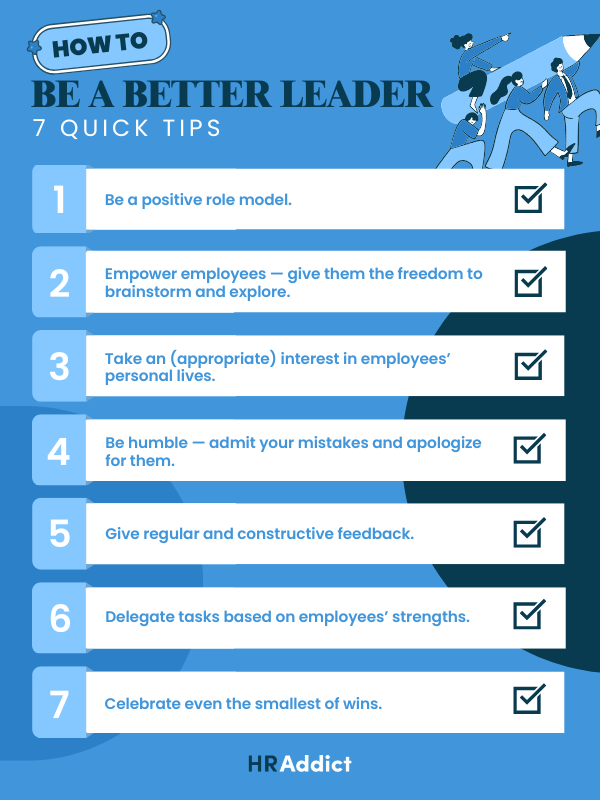There is a long-held conventional wisdom in the workplace that leadership and management are two totally different entities. Good leaders possess qualities and strengths that good managers might not, yet in many ways, these leadership skills are far more important to an organization than being able to report on a budget or explain a pie chart.
So, what are these skills? And how do you adapt your management style to be a better leader, without compromising the technical aspects of management? There are, after all, countless books written on the subject.
Luckily, we have saved you some time and created some handy tips to help you tackle these questions. Follow the steps below, and we guarantee you will become a more effective and successful leader at work…
What is an effective leader?
An effective leader is someone who inspires and guides their team to achieve shared goals while fostering a positive and productive work environment. They possess key qualities such as clear communication, emotional intelligence and accountability, enabling them to build trust and motivate their team.
Effective leaders empower others by delegating tasks, providing constructive feedback and offering support. They set clear, attainable goals and lead by example, demonstrating integrity, humility and resilience. Moreover, they adapt to challenges, make informed decisions and encourage innovation, all while creating a culture of collaboration, learning and mutual respect.
How to assess whether you’re a good leader
Assessing whether you’re a good leader requires honest self-reflection and feedback from others. Here are a few steps to evaluate your leadership:
- Seek feedback. Ask for candid feedback from your team, peers and superiors. A good leader is open to constructive criticism and regularly checks in with their team for insights on areas of improvement.
- Evaluate team performance. Assess how well your team performs under your leadership. Are they motivated, productive and hitting goals? A strong team often reflects effective leadership.
- Measure your communication skills. Reflect on how clearly you communicate goals, provide feedback and listen to others. Effective leaders are transparent, approachable and skilled at resolving conflicts.
- Check for adaptability. Good leaders are adaptable and open to change. Consider how well you handle challenges, whether you’re open to new ideas and if you encourage innovation within your team.
- Gauge your emotional intelligence. Strong leaders show empathy, self-awareness and emotional control. Do you understand your team’s emotions, offer support and build positive relationships?
By consistently evaluating these areas, you can better understand your strengths and where you might need growth as a leader.
15 tips to be a better leader
Becoming a better leader isn’t a one-time event — it’s a continuous process. And with these 15 tips and strategies, you’ll make sure that you’re developing your leadership skills consistently.
1. Be a positive role model
It’s an old adage, but it still rings true: you should never ask someone to do something that you would never do yourself. This is one of the cornerstones of effective leadership and encapsulates the mantra of leading by example.
Psychology expert Kendra Cherry agrees: “If you want to become a better leader, work on modeling the qualities that you would like to see in your team members”.
This means being the last person to leave the office during a tight deadline, and the first to come in. “As a result,” adds Cherry, “group members will admire you, and work to emulate these behaviors”.
2. Become an effective communicator
Strong communication is a vital component in the success of any organization, and it should be at its most effective when coming from management. It should also work both ways, though, and a good leader knows how to listen as much as they dictate.
When talking to staff, remember the following:
- Be friendly and approachable
- Give your employees your undivided attention when they’re talking to you (shut your office door, and ignore or politely bat away non-urgent phone calls)
- Make eye contact as they speak (don’t be checking your phone or your emails)
- Maintain the confidentiality of the conversation
This last point is important, as it will build trust between you and your staff. It’s also a good idea to clarify any points raised in an email afterwards to make sure you’re both on the same page.
“Be sure your staff knows of your expectations for them,” says entrepreneur Murray Newlands. “But also let them know they may freely and openly discuss workplace issues with you.”
3. Have an ally
Management is often seen as a lonely perch, but it doesn’t need to be. Every leader has someone they can bounce ideas off, or turn to for advice.
Whether this is a trusted colleague within your team or someone with similar skills and experience away from the office, it’s always a good idea to get a second opinion on something.
Former manager John Brandon says this is a vital part of the learning process. “I had a few coworkers who tried to give me advice,” he says. “But I had the mindset of a lone wolf and tuned it out. I was wrong. It’s critical to look for this feedback as a development step.”
4. Empower employees
Encouraging creativity is an essential part of developing your staff. If an employee comes to you with a problem on a project, you shouldn’t just tell them what to do; you should try to guide them so that they come up with the answer themselves.
“If you want your staff to do their best work, you need to give them the freedom to brainstorm and explore,” says Alexander Negresh, a marketing director with a cloud storage company. This shouldn’t just be a token gesture either. “Be open to your team’s ideas and suggestions, and be ready to consider them and possibly develop them further.”
You should also try to challenge your staff. There is nothing more boring than doing the same tasks day in day out, and it can cause dissatisfaction in the office. Newlands argues that learning and mastering new challenges gives employees a sense of achievement instead.
Guide and train your staff to do different things. “Along with constructive feedback, it shows that you have confidence in their skills and that you value them as part of the organization,” says Newlands.
5. Mix business with personal
Although some would contend that this isn’t always a good idea, Newlands disagrees. He argues that employees feel more valued when their boss takes an interest in their family life or their recreational activities.
Of course, you don’t need to go overboard, but politely asking after a spouse or how someone’s golf season is going once in a while will endear you. “It demonstrates that you care about them as human beings,” says Newlands, “and that you don’t just consider them as another name on the company payroll.”
Additionally, share a few personal tidbits about yourself as well. During meetings, don’t just jump straight into the budget report; share a recent story about something funny your kids said or a recent vacation you took. “Let your employees know a little more about you,” says Brandon. “Let them know you are a human too, and that you exist as a person outside of work.”
6. Show humility
Being able to admit your mistakes — and apologize for them — is not leadership weakness; it is good leadership. People can forgive mistakes if the person responsible holds their hands up to it; in fact, it can even work in your favor.
“When you admit a mistake, your employees feel safe admitting a mistake,” explains Newlands. “Accepting that individuals make mistakes will create a more cooperative atmosphere in your company.”
Additionally, when something goes well, ensure the team gets the credit rather than you. Put the emphasis on their achievements more than your own. “Such actions show your human side, and help you gain the respect of employees and customers alike,” he adds.
7. Be fair
One of the great debates of virtual and face-to-face management is the benefits of praise versus criticism as a motivating factor, but the reality is most employees simply value fairness. If they have done something well, they expect to be praised, and if they have performed poorly, they can expect the opposite.
Brandon thinks you should be much quicker to focus on the positives, though. “We live in complex, competitive times,” he argues. “People are inundated with too many tasks and not enough time, and need constant encouragement. Always point out the ‘wins’, no matter how small.”
That said, constructive criticism has its place. If someone is performing poorly and doesn’t respond to an “arm around the shoulder”, then maybe you need to try a more robust approach.
As long as you are fair and constructive, this can have a positive impact on some employees — just be careful: “If you do have to criticize,” adds Brandon, “think seriously about the impact first.”
8. Reward success
In a similar vein, team success should be celebrated accordingly — especially when it’s a big result. Depending on the team’s budget, taking the team out for celebratory drinks or a banana sundae can be a great way to demonstrate that their hard work and effort is appreciated, and maintain morale within the office.
It can also build momentum. “A big success is something to cherish and relish when it happens,” says Brandon. When it is rewarded properly, it can motivate people to push further on the next project.
9. Give regular feedback
One-on-one feedback is a very delicate art and can separate the good leaders from the bad. There is nothing worse as an employee than realizing your annual performance review is essentially a copy-and-paste with just the names changed; it shows that, as a boss, you couldn’t really care less about the progression and development of your staff.
It also demonstrates that you don’t know the strengths and weaknesses of your team, and therefore how to best utilize them. The best way to avoid this is to meet one on one regularly so that you can set goals and assess them more than once a year.
You should use these meetings to discuss any concerns the employee may have, as well as to look at their performance informally. It’s important to highlight where people are doing well — and you should always emphasize the positives more — but you should also look for areas of improvement.
“If you’re not honest, people won’t know what you think of them,” says Taso Du Val, a recruitment expert. “And if they don’t know that, then they will never be able to improve.”
10. Learn from your team
In a leadership role, never assume that you know everything — because the fact is you don’t. Business consultant Brent Gleeson argues that delusions of omnipotence are an automatic path to failure, and should always be avoided.
“Good leaders know when to take charge of a situation, and when to let the more knowledgeable and experienced people lead the way,” he says. This isn’t laziness or poor leadership; it is an invaluable opportunity to learn and develop from the talent you have available to you, and to take on board new skills.
Even the most experienced leaders cannot be experts in everything, and knowing when to take a step back is an important part of management. “Soak up as much knowledge as you can and learn something new every day,” concludes Gleeson. “In the long run, you’ll be better informed when making strategic decisions.”
11. Delegate effectively
Delegating effectively is a crucial leadership skill that empowers your team and ensures productivity.
It’s important to delegate tasks based on each team member’s strengths and growth areas. Indeed, trusting your employees with responsibility not only lightens your workload but also allows them to develop skills and confidence.
That said, avoid micromanaging — set clear expectations and offer support when needed, but give them the autonomy to execute.
12. Set clear goals
Clear and actionable goals help align your team with the company’s vision.
When setting goals, use the SMART framework — Specific, Measurable, Achievable, Relevant and Time-bound — to ensure your objectives are realistic and understandable. Share these goals with your team, and make sure everyone understands their individual roles in achieving them.
And remember to regularly review progress to maintain focus and motivation.
13. Be accountable
Accountability is one of the cornerstones of great leadership. Taking responsibility for your decisions, actions and mistakes demonstrates integrity and sets a strong example for your team. When leaders own up to their mistakes, especially, it fosters a culture of openness and trust.
By being accountable, you create an environment where team members feel comfortable taking risks and learning from their own errors, knowing that transparency is valued.
14. Celebrate small wins
Recognizing and celebrating even the smallest wins can significantly boost team morale and motivation. Acknowledging minor achievements, whether through verbal praise or small rewards, helps maintain momentum and reminds employees that their efforts are appreciated.
Celebrations also foster a positive work environment and keep the team focused on larger goals. Not only that, but regularly recognizing progress prevents burnout and helps employees feel valued, which in turn drives long-term success.
15. Embrace continuous learning
Great leaders are lifelong learners. And embracing continuous learning shows that you’re open to growth and improvement.
Stay updated on industry trends, leadership strategies and new technologies to remain relevant and informed — and encourage your team to do the same by offering professional development opportunities and resources.
Continuous learning not only sharpens your skills but also keeps you adaptable in a rapidly changing work environment, making you a more effective and forward-thinking leader.
In a snapshot, here the top 7 leadership tips to keep in mind:

Final thoughts
Remember: the main difference between good bosses and bad ones in the workplace is simple. Good leaders put their employees first, while bad ones are only focused on themselves.
Always consider the impact of others on any decision you make, and never prioritize personal gains over the best interests of those you lead. Follow this advice, and you won’t go far wrong.
What makes a great leader in your opinion? Are the above points a good indicator? Let us know in the comments section below!
This article is a partial update of an earlier version originally published in 2019.

